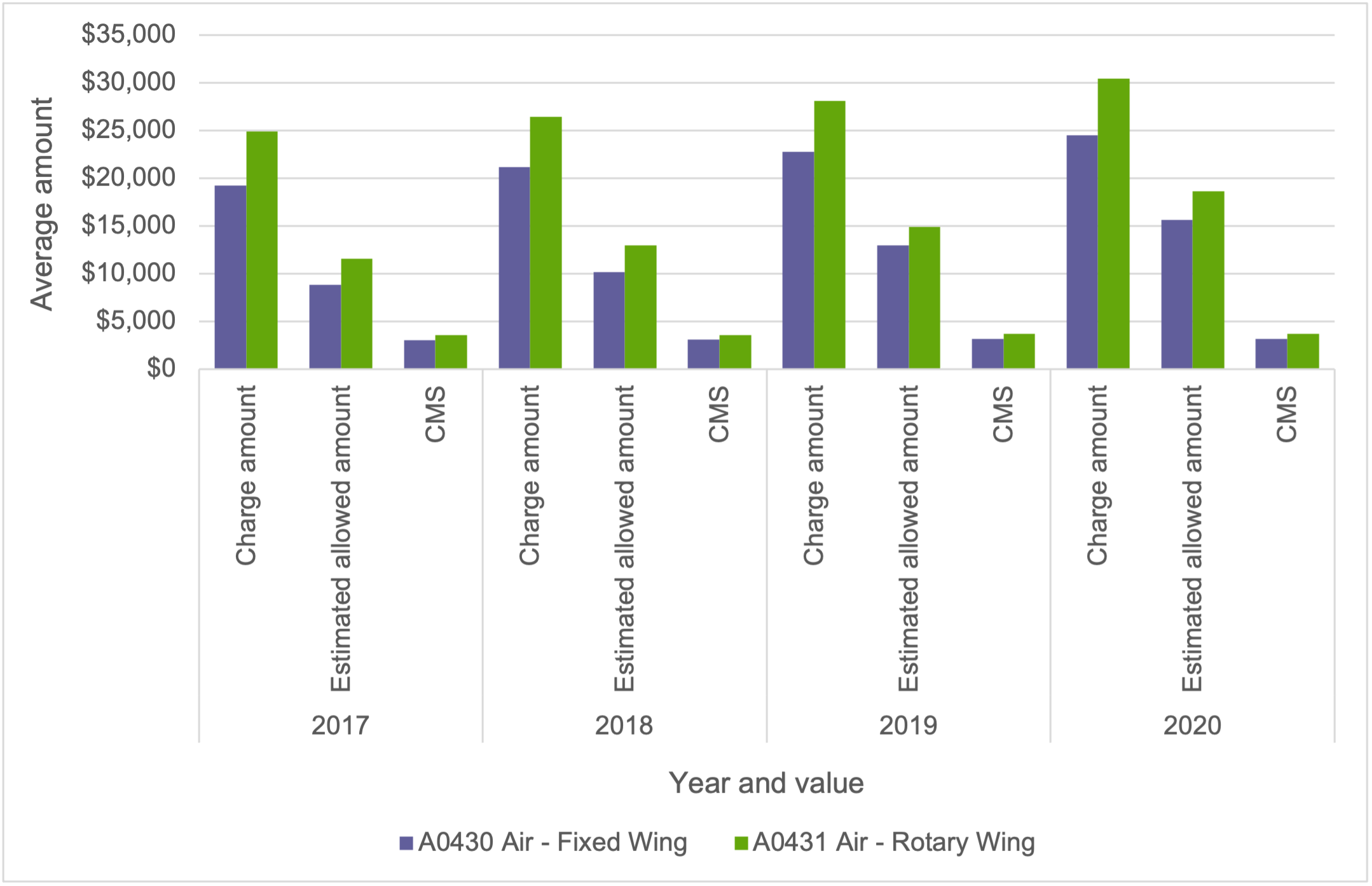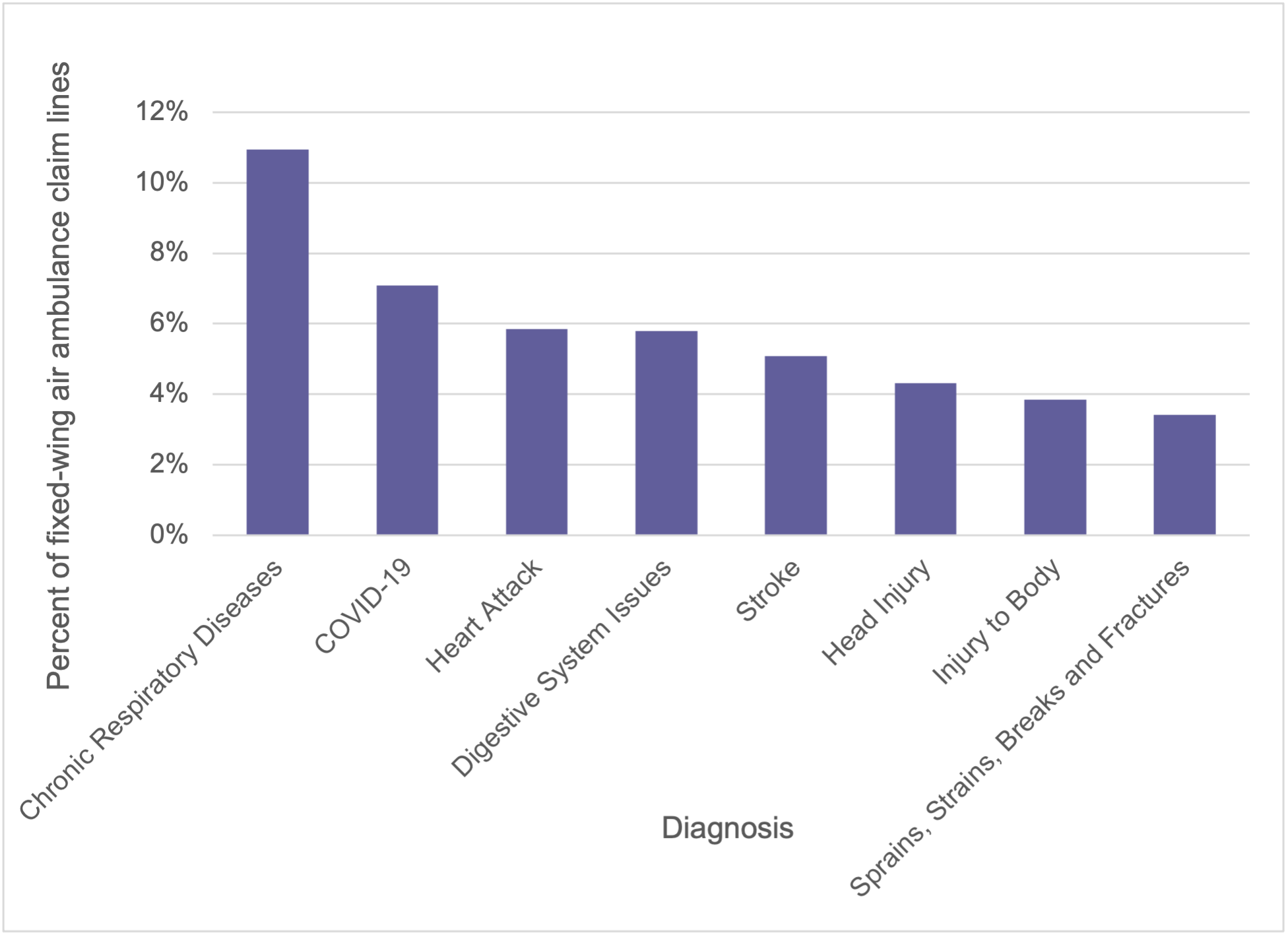- Center on Health Equity & Access
- Clinical
- Health Care Cost
- Health Care Delivery
- Insurance
- Policy
- Technology
- Value-Based Care
Air Ambulance Costs Increased From 2017 to 2020
Aligned with increases in costs for both airplane and helicopter air ambulance transport, average estimated air ambulance costs rose 76.4% from 2017 to 2020, according to Robin Gelburd, JD, president of FAIR Health.
The average estimated allowed (in-network) amount for base fixed-wing air ambulance transport (not including mileage charges) rose 76.4%, from $8,855 in 2017 to $15,624 in 2020 (Exhibit 1). This was part of a general rise in costs for both fixed-wing (airplane) and rotary-wing (helicopter) air ambulance transport during this period, including increases in average billed charges, estimated allowed amounts for privately insured patients and Medicare reimbursements.1,2 These are among the findings in FAIR Health’s new white paper, Air Ambulance Services in the United States: A Study of Private and Medicare Claims.
Exhibit 1. Average Charge Amounts, Estimated Allowed Amounts and CMS (Medicare Reimbursement) Amounts for Fixed-Wing and Rotary-Wing Air Ambulance, without Mileage Fees, 2017-2020
(Source: FAIR Health)

The average charge associated with fixed-wing air ambulance transports rose 27.6%, from $19,210 in 2017 to $24,507 in 2020, the study reports. The average Medicare reimbursement rose 4.7%, from $3,071 to $3,216.
The average charge associated with rotary-wing air ambulance transports rose 22.2%, from $24,924 in 2017 to $30,446 in 2020. The average estimated allowed amount rose 60.8%, from $11,608 to $18,668. The average Medicare reimbursement rose 4.7%, from $3,570 to $3,739.
Among the other findings in the report:
- Air ambulance claim lines increased 30% from 2016 to 2020 as a percentage of all ambulance (ground and air) claim lines (0.7% in 2016 to 0.9% in 2020).3
- In 2020, the second most common diagnosis associated with fixed-wing air ambulance transport was COVID-19, accounting for seven percent of fixed-wing air ambulance claim lines (Exhibit 2).
Exhibit 2. Most Common Diagnoses Associated with Fixed-Wing Air Ambulance, 2020
(Source: FAIR Health)

The states with the highest use of fixed-wing air ambulance transport as a percentage of all medical claim lines in that state in 2020 (in order from highest to lowest use) were Alaska, Wyoming, South Dakota, Montana, and New Mexico. The five states with the lowest use (in order from lowest to highest use) were Virginia, Kentucky, New Hampshire, New Jersey, and Vermont.4
Based on the origination point of the flight, the states with the highest average mileage for fixed-wing air ambulance transport in 2020 were Alaska (455 miles), Florida (444 miles), Georgia (429 miles), North Carolina (401 miles), and Indiana (382 miles).
The states with the highest use of rotary-wing air ambulance transport as a percentage of all medical claim lines in that state in 2020 were Idaho, South Dakota, New Mexico, West Virginia, and Wyoming.
The states with the highest average mileage for rotary-wing air ambulance transport in 2020 were Hawaii (126 miles), North Dakota (115 miles), Wyoming (110 miles), Nebraska (94 miles), and New Mexico (90 miles).
In the period 2016-2020, air ambulance claim lines were predominantly associated with individuals 65 years and older. Patients in that age group accounted for 55.4% of claim lines for fixed-wing transport and 63.6% of claim lines for rotary-wing transport.5
The top diagnoses associated with fixed-wing air ambulance rides from 2016 to 2020, as attributed by ambulance providers, were (from most to least common) digestive system issues; heart attack; sprains, strains, breaks and fractures; chronic respiratory diseases; and general signs and symptoms involving the circulatory and respiratory systems.
The top diagnoses associated with rotary-wing air ambulance rides from 2016 to 2020 were cerebrovascular issues and diseases, heart attack, head injury, injury to body, and stroke.
In emergencies, in the period 2016-2020, patients transported by air ambulance were much more likely to be admitted as inpatients to a hospital than patients transported by ground ambulance.
In the period 2016-2020, the diagnosis with the highest inpatient admission rate after a fixed-wing air ambulance transport was newborn disorders. The diagnosis with the highest inpatient admission rate after a rotary-wing air ambulance transport was complications in newborns.
Air ambulance services have been the subject of substantial policy focus. We hope that this study of air ambulance transport proves productive to policy makers, researchers, payers, providers, and consumers seeking to better understand this corner of the health care system.
Some of the findings in this report are also available in the form of two infographics, the first on growth, costs and geography, the second on demographics and diagnoses.
For the new white paper, click here.
Robin Gelburd, JD, is the founding President of FAIR Health, a national, independent nonprofit organization that serves as a trusted leader in health care cost transparency, data analytics and benchmarks. FAIR Health possesses the nation’s largest collection of private health care claims data, which includes over 35 billion claim records and grows at a rate of over 2 billion claim records a year. Certified by the Centers for Medicare & Medicaid Services as a national Qualified Entity, FAIR Health also receives data representing the experience of all individuals enrolled in traditional Medicare Parts A, B and D. Robin is a nationally recognized expert on health care policy and health literacy and transparency. Selected as one of Crain’s 2019 Notable Women in Health Care, she has been invited to speak to organizations and federal and state agencies across the country and world.
References
1) Costs shown here are for base fees only and do not include mileage fees. Both miles traveled and rates charged or paid per mile can vary widely.
2) A charge is the provider’s undiscounted fee, which a patient may have to pay when the patient is uninsured, or when the patient chooses to go to a provider who does not belong to the patient’s plan’s network. An allowed amount (which FAIR Health estimates) is the total fee paid to the provider under an insurance plan. It includes the amount that the health plan pays and the part the patient pays under the plan’s in-network cost-sharing provisions (e.g., copay or coinsurance if the patient has met the deductible).
3) "Claim lines” are the individual procedures or services listed on an insurance claim.
4) The states with the lowest use do not include Rhode Island and Delaware, which had no utilization of fixed-wing air ambulance services.
5) Because FAIR Health data include 100% of the Medicare Fee-for-Service population but not 100% of the privately insured population, this may affect age-related results.
Trends in Hospital Pricing for Vulnerable Emergency Department Users, 2021-2023
December 4th 2025Self-pay emergency department prices rose significantly from 2021 to 2023, especially at for-profit and system-affiliated hospitals, highlighting growing affordability challenges for uninsured and underinsured patients.
Read More
